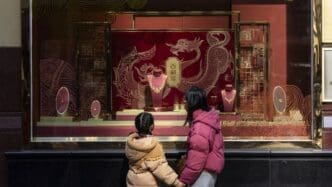China’s Lunar New Year holiday has marked a new peak in tourism and spending, offering a hopeful sign for the country’s economic recovery. The eight-day celebration saw a significant increase in travel and consumption, with official data detailing impressive figures. Yet, questions linger about whether this momentum will persist amidst ongoing economic difficulties.
With over 501 million trips taken domestically and tourism expenditure reaching 677 billion yuan, this year’s Lunar New Year holiday marked a 5.9% rise in travel from last year. The encouraging figures, however, represent more than just festive cheer; they reflect the government’s efforts to stimulate economic activity. Whether these gains are sustainable remains to be seen.
Travel during the Lunar New Year saw a substantial jump, with 501 million trips within China, a 5.9% increase from the previous year. This growth coincides with the government’s initiatives to revitalize the economy. However, some analysts caution that this surge could be a temporary release after a challenging year.
Tourism spending during the holiday reached 677 billion yuan, marking a 7% growth compared to last year. Despite this progress, the average daily expenditure per trip remains 5% below pre-pandemic levels. The balance between recovery and sustained growth is delicate and uncertain.
Cross-border travel also saw an upswing, averaging 1.795 million trips per day during the holiday, slightly above pre-pandemic numbers. This is largely attributed to increased foreign visitor numbers, which rose by 22.9% compared to 2024.
China’s introduction of visa-free access for several countries has fueled this increase, as noted by Foreign Ministry spokesperson Lin Jian. He highlighted a 150% rise in foreign visitors during the holiday, though full details of these figures are unspecified.
The film industry experienced a renaissance, with 187 million people attending cinemas over the holiday. This pushed box office revenues to 9.5 billion yuan, setting a new record.
The animated film ‘Nezha 2’ led the box office, becoming China’s top-grossing film. Backed by government policies promoting consumption, this surge in entertainment spending is part of a broader strategy to stimulate economic activity.
Despite these successes, challenges such as job insecurity and a weakened property market continue to overshadow the economy.
The holiday’s spending spree was encouraged by government initiatives aimed at boosting consumption. Policies such as public subsidy campaigns and cinema vouchers played a role in driving economic activity.
In January, the Finance Ministry allocated 81 billion yuan for trade-in programs to encourage spending on consumer goods. These efforts reflect the government’s strategy to mitigate economic difficulties through domestic consumption.
Internationally, China faces significant economic pressure, including new tariffs imposed by the Trump administration on Chinese imports.
In response, China announced countermeasures targeting the U.S., including tariffs on coal, LNG, and agricultural machinery. These measures add another layer of complexity to China’s economic landscape.
Several industries, including film and consumer electronics, benefited from the holiday season’s economic activities. Analysts at Citi note robust performances across these sectors due to policy support.
Household appliances and inbound tourism also saw positive results, although sustained growth remains uncertain amidst broader economic challenges.
China’s economic strategy continues to focus on expanding domestic consumption to drive growth and resilience.
Chinese leader Xi Jinping has prioritized expanding domestic consumption, aiming to boost both consumer and business sentiment.
The recent data, while encouraging, may represent a temporary release of pent-up demand rather than a long-term trend. Future economic strategies will need to address both internal and external challenges to maintain progress.
Experts suggest caution in interpreting the positive holiday data, which may not indicate long-term recovery. The economic challenges China faces require careful navigation of domestic and international issues.
The pressure from external economic relations and internal market adjustments will test China’s ability to sustain recent gains.
China’s record-breaking Lunar New Year spending highlights a mixed economic landscape with both optimism and ongoing challenges. As the country navigates internal and external pressures, the sustainability of recent growth remains uncertain.
China’s Lunar New Year results show both potential for economic recovery and significant challenges ahead. Sustaining this growth will be crucial as the nation tackles internal and external pressures.








